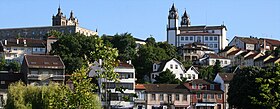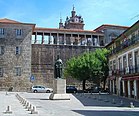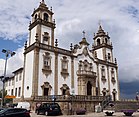
Back بازو Arabic Viseu AST Vizeu Azerbaijani Візеу Byelorussian Візэў BE-X-OLD ভিসেউ BPY Viseu (Portugal) Breton Viseu Catalan Визеу CE Viseu (munisipyo sa Portugal, Distrito de Viseu, lat 40,67, long -7,92) CEB
Viseu | |
|---|---|
|
Clockwise: View of Viseu; historic center; Igreja da Misericórdia; Praça D. Duarte; Viseu Cathedral. | |
 | |
| Coordinates: 40°40′N 7°55′W / 40.667°N 7.917°W | |
| Country | |
| Region | Centro |
| Intermunic. comm. | Viseu Dão Lafões |
| District | Viseu |
| Parishes | 25 |
| Government | |
| • President | Fernando Ruas (PSD) |
| Area | |
• Total | 507.10 km2 (195.79 sq mi) |
| Population (2022) | |
• Total | 100,105 |
| • Density | 200/km2 (510/sq mi) |
| Time zone | UTC+00:00 (WET) |
| • Summer (DST) | UTC+01:00 (WEST) |
| Local holiday | September 21 |
| Website | www |
Viseu (Portuguese pronunciation: [viˈzew] ⓘ) is a city and municipality in the Centro Region of Portugal and the capital of the district of the same name, with a population of 100,105 inhabitants[1] in the entire municipality, and center of the Viseu Dão Lafões intermunipical community, with 267,633 inhabitants.
Settled during the period of the early Iberian Castro culture, the territory of Viseu was populated by a series of cultures including the Romans, Suebs, Visigoths and Moors. During the Roman occupation of Iberia, Viriathus, the rebel leader of the Lusitanians, is assumed to have lived for a time in the vicinity. During the Middle Ages, the city often served as a seat for Visigothic nobles (such as King Roderic), and is considered one of the probable birthplaces of Afonso Henriques, first King of Portugal.[citation needed]
Viseu is a regional economic hub with a strong wine industry and is the seat of the international conglomerate Visabeira. The city is also a cultural center, home to the nationally acclaimed Grão Vasco Museum, the seat of the Roman Catholic Diocese of Viseu, and a center for higher learning institutions, namely the Catholic University of Portugal and the Polytechnic Institute of Viseu.
- ^ "Portal do INE". www.ine.pt. Retrieved 2023-06-28.






